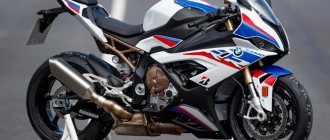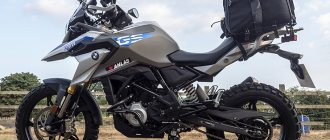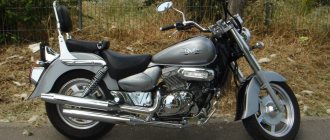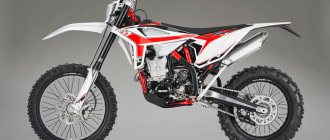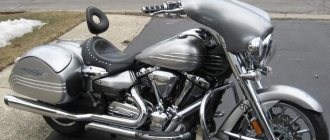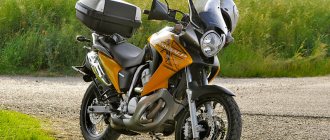BMW G450X
Model class : hard enduro
Years of production/sales : 2008-2014
The BMW G450 X was first presented in the fall of 2007 at the EICMA exhibition in Milan, and official sales began in 2008. The appearance of this motorcycle was due to BMW’s desire to offer the market a flagship hard enduro model and compete with the then Japanese and European leaders in the class.
Despite the fact that BMW bought Husqvarna in 2007, the BMW G450X was developed from scratch, without the use of Husqvarna technologies and developments. Excellent technical characteristics and an interesting layout still have not made the model a flagship on the modern hard enduro market. Meanwhile, the experience of creating the BMW G450X was not in vain and in 2010 many Husqvarna models received BMW engines.
The BMW G450X is based on a 1-cylinder 4-stroke liquid-cooled engine assembled by Kymco (Taiwan) and producing 52 hp. power and almost 43 Nm of torque. A special feature of the engine layout is that the crankshaft is turned back and the clutch is located directly on it. The BMW G450X was originally supplied with a power output of 40.8 hp, which complied with Euro 3 emissions standards, but this restriction could be removed from the dealer by increasing the maximum power to 52 hp, but in this case the motorcycle would no longer complied with Euro-3 standards.
Other features of the BMW G450X include a steel frame, fully adjustable suspension in the form of a Marzocchi front inverted fork with a 45 mm diameter of feathers and an Ohlins rear monoshock absorber, a 5-speed gearbox and 121 kg of curb weight.
The fuel tank is located under the seat, and the frame is designed to tilt the engine forward as much as possible. All this significantly lowers the center of gravity and increases handling and control of the motorcycle. Also, the frame design allowed BMW to use one large cooling radiator, instead of two on the sides, as is implemented on most motorcycles in this class. This simplifies the design, reducing the number of elements of the cooling system, and also protects the radiator well from damage in the event of falls.
The motorcycle's drive system is also noteworthy. The driving sprocket of the motorcycle is located on the axis of the pendulum, so when the rear suspension is in operation, the length of the chain remains unchanged. This design significantly extends the life of the chain and sprockets, and also makes the transmission smoother, however, when replacing the drive sprocket, it will be necessary to remove the pendulum.
Despite interesting solutions and technologies, the BMW G450X model was sold until 2014, after which it disappeared from the BMW motorcycle line.
Test drive BMWG 450X
Last year, Alexey Naumov won the title of Russian Enduro Champion. 2009 – second place. Has fortune turned away? Or his new BMW G450X motorcycle is to blame.
It somehow turned out ugly. Bavarian motorcycle manufacturers all over the world managed to be known as the trendsetters in the world of off-road touring motorcycles, but they did not have a real enduro designed for hard off-road. Finally, BMW Motorrad got around to plugging the gap in its model line by offering the BMW G450X this season. So that the newcomer would not be looked at askance and he could win his spot in the sun, where the Austrians and the Japanese rule, the Bavarians followed the proven path. The BMW G450X was “charged” to participate in countless world enduro and cross-country competitions. Our compatriot Alexey Naumov, who started competing for the BMW Enduro Russia team in 2009, also received a couple of motorcycles. At the moment, in our country, hardly anyone knows more about the G450X than Alexey. We talked about how the athlete lived with the new technology.
Naumov Alexey
Date of birth: May 11, 1978 Place of birth: Kolomna Height: 180 cm Weight: 88 kg Trainer: Povarov Sergey Nikolaevich Education: Kolomna Industrial Pedagogical College Specialty: process technician Marital status : married First time on a motorcycle : at 15 years First motorcycle: “Minsk” First race : rally-raid “Transaero”, Kolomna, October 23, 1999 First victory : Moscow Region Enduro Championship 2000 Worst moment in career : injury to the right and left knees in 2003 Hobbies: windsurfing, snowboarding
– How did you think of the BMW G450X after your first meeting?
– My first test session took place last winter. Frozen track, studded tires. Honestly, at that time I absolutely did not understand the G450X either in terms of handling or in the ways of controlling it during jumps. Before that, I drove KTM for more than three years. The control technique developed over the years for this motorcycle was completely unsuitable for German enduro. Maximum low center of gravity. Smoother and smoother engine. By installing the drive sprocket on the same axis with the rear pendulum support, the “ragged” moments characteristic of conventional “crossovers”, which arise due to sagging of the main drive chain, are eliminated. The transmission of torque to the rear wheel is really felt constantly, without any dips or jerks. I had to get used to all this good stuff.
– How long did it take to adapt and develop a new piloting strategy?
– I immediately gave up the habit of constantly keeping the engine in the high speed zone. The G450X engine is tuned for maximum traction in the midrange and low end. Plus long passes. After riding for about 30 hours, I began to understand the behavior of the motorcycle and control it during jumps. Only on high jumps did the shock absorbers sometimes break during landing. The reason is my weight of under 90 kg and equipment. The standard suspension with Marzocchi stays and Ohlins monoshock does its job well, but everything is designed for the average 75kg athlete. Later, in the German tuning studio Speed Brain, which cooperates with the BMW Motorrad factory team, the suspensions were adjusted to my weight. We installed stiffer springs and filled in new oil. The front fork no longer “folded” when landing on the ramps. It was completely adjusted to the parameters of motocross motorcycles.
– What other modernization has your “war horse” undergone?
– Lowered the steering wheel a little – new spacers made it 15 mm lower. The standard exhaust system “strangles” the engine for the sake of European economic standards. We replaced the entire exhaust tract with a branded kit from Akrapovic. The engine began to breathe. The increase was about 5 liters. With. Traction at low and medium speeds has increased, according to my estimates, by 20%! Well, depending on the route, I experiment with the star. I need a longer first gear - I set the drive sprocket with 14 teeth, and the driven sprocket with 48 teeth. The ground is rocky and a trial is needed - the drive sprocket is mounted with 13 teeth.
– Remember the most offensive moment with the BMW G450X.
– Near Tver, at the next stage of the enduro championship, a stick flying out from under the front wheel pierced the “body” of the BMW G450X in the area of the fuel pump, cut off the fitting and tore off the hose. While I was resuscitating the motorcycle, which was also stuck up to its ears in mud, it lost its leading position. I arrived only seventh.
– According to you, the BMW G450X is a wonderful motorcycle, capable of providing worthy competition to purebred motocross machines and at the same time being at its best in enduro raids. However, this year you are not the champion. What is the reason?
– The motorcycle has nothing to do with it. Competition has become more serious. There are a lot of great racers emerging. As for the motorcycle, while remaining practically a standard model, it has never let me down. During the season I didn’t even adjust the engine valves. Let's train! The BMW G450X has more than enough sporting potential.
Text: Automobiles Magazine
Specifications
Technical characteristics of the BMW G450X:
| Model | BMW G450X |
| Motorcycle type | hard enduro |
| Year of issue | 2008-2014 |
| Frame | steel |
| engine's type | 1-cylinder 4-stroke |
| Working volume | 449.5 cc |
| Bore x Stroke | 98x59.6 mm |
| Compression ratio | 12:1 |
| Cooling | liquid |
| Number of valves | DOHC, 4 valves per cylinder |
| Fuel supply system | injector |
| Ignition type | digital |
| Maximum power | 52 hp at 7000 rpm |
| Maximum torque | 42.8 Nm at 6500 rpm |
| Transmission | 5-speed |
| type of drive | chain |
| Front tire size | 90/90 — 21 |
| Rear tire size | 140/80 — 18 |
| Front brakes | 1 disc, 260 mm, 2-piston caliper |
| Rear brakes | 1 disc, 220 mm, 1-piston caliper |
| Front suspension | inverted fork (adjustable compression and rebound), stroke - 300 mm |
| Rear suspension | pendulum with monoshock absorber (all adjustments), stroke - 320 mm |
| Overall dimensions (LxWxH) | 2200x806x1475 mm |
| Seat height | 955 mm |
| Gas tank capacity | 8 l |
| Maximum speed | 145 km/h |
| Motorcycle weight (curb) | 121 kg |
The new BMW fourth series coupe has been completely declassified
The BMW “Quartet” has become, perhaps, one of the most anticipated new products of this year. Despite the relatively low sales volume of the outgoing model, its successor has become a symbol of the beginning of a new chapter in the history of car design for the Bavarian brand. Its leitmotif turned out to be the huge vertical nostrils of the radiator grille, stretching from the edge of the hood to the bottom of the bumper and referencing the classic pre-war BMW models.
The famous Hofmeister curve, which over the past sixty years has become a signature feature of the brand, has disappeared with the change of generations, as it did on the eight-series four-door Gran Coupe introduced a year ago. The rear lights with a characteristic pattern are also reminiscent of the G8. Even the base two-door models now have additional side air intakes in the bumper, although they are slightly larger on models with the M package and more powerful versions. And from the rear, cars with an M body kit can be identified by trapezoidal exhaust pipes, a “diffuser” in the bumper and a small spoiler on the trunk lid. The already outstanding drag coefficient Cd (0.23) has been reduced by another 0.015. To increase the rigidity of the body, reinforcements were added under the hood, on the bottom and at the mounting points of the suspension elements.
The new coupe of the fourth series is noticeably larger than the previous one: the length of the two-door is 4768 mm versus 4638 mm, the width is 1852 mm (plus 27 mm), although the height has remained virtually unchanged (1383 mm). The wheelbase has also grown by 41 mm (to 2851 mm). For the sake of better handling, the center of gravity was moved 21 mm lower, the weight distribution along the axles was distributed in a ratio of 50:50, although the engineers, alas, could not avoid an increase in curb weight: for example, the rear-wheel drive BMW 420d coupe added as much as 140 kg and now weighs an impressive 1605 kg.
With the change of generation, the salon has retained the same architecture, although there are plenty of new things here too. They are the same as those of the related “three rubles”: a new steering wheel, a 12.3-inch diagonal virtual instrument display and a ten-inch media system screen with the BMW OS 7.0 operating system (there is a remote update function and the latest BMW Maps navigation) available for an additional fee. The “Four” has lost the previous scattering of buttons on the center console - the climate control and audio system control units are designed more neatly, so the interior has become visually lighter.
At the start of sales, the range of engines will consist of three petrol and one diesel units. Versions 420i (184 hp, 300 Nm) and 430i (258 hp and 400 Nm) are equipped with two-liter turbo-fours, and at the top of the gasoline range is the all-wheel drive modification M440i xDrive with an in-line turbo six, which produces 374 hp. and 500 Nm. The two-liter turbodiesel on the 420d version develops 190 hp. and 400 Nm (xDrive all-wheel drive is available for an additional fee), and a little later it will be joined by six-cylinder modifications 430d xDrive (286 hp, 650 Nm) and M440d xDrive (340 hp, 700 Nm).
All diesel units now have dual-flow turbochargers. Unlike the updated “five” and “six” Gran Turismo, presented last week, a mild-hybrid add-on in the form of a 48-volt starter-generator with an output of 11 hp, which helps in the first seconds of acceleration and works as part of the start-stop system , not all engines are eligible: junior gasoline turbo-fours have not yet been affected by electrification. All presented modifications are paired with an eight-speed automatic transmission. But there is still silence about rechargeable hybrids - most likely, they will not be in the fourth series family at all.
As for the chassis, the “four” differs from the “three” not only in the sportier suspension and power steering calibrations. At the front, the negative camber of the wheels has been increased and different steering rods have been installed, and at the rear the track has been widened by 23 mm. Standard wheels are 18 inches in diameter. Adaptive suspension, an electronically controlled rear differential and more powerful M Sport brakes can be ordered.
Already in the initial versions, the new “four” is equipped with all-LED optics, and adaptive laser-phosphor headlights are offered for an additional fee. An expanded range of auxiliary electronics includes automatic braking and adaptive cruise control, which can keep the car in its lane, as well as reverse assist.
Deliveries of commercial vehicles will begin in the fall. The new coupe of the G22 series will appear in Russia, the prices are already known: from 3 million 130 thousand rubles for the BMW 420i in the initial configuration, and it already includes the external M package. Within a year, the company will present a new “four” with a convertible body (with a soft top instead of the current hard folding roof!), a five-door version of the Gran Coupe and a “charged” BMW M4.
| Modification | Engine | Starting price, rub. |
| BMW 420i | petrol, 2.0 l, 184 hp | 3 130 000 |
| BMW M440i xDrive | petrol, 3.0 l, 387 hp | 4 550 000 |
| BMW 420d | diesel, 2.0 l, 190 hp | 3 150 000 |
| BMW 420d xDrive | diesel, 2.0 l, 190 hp | 3 290 000 |
Beautiful?... Meet the BMW iX
In November, a completely new BMW model will go into production - the iX electric crossover, which can be called the “X-fifth of the new era.” Although they are similar only in size. Pre-production copies have already begun to be demonstrated “statically” at private shows this summer. “Do you give me a ride?” - asks the impatient audience. “No, we’re just showing it,” BMW replies. Beautiful?..
The owner of this BMW will not be able to open the hood himself; this option is only available to service employees. And this is already a reason to argue about this car. It also has a hexagonal (!) steering wheel and the latest iDrive 8 multimedia. Plus - power up to 523 horsepower and price in Russia - 8.5 million rubles. But all this fades somewhat into the background in comparison with appearance.
There will probably be a lot of vivid epithets and metaphors in the comments. The crossover received strange proportions, as if reflected in a distorting mirror. The BMW iX feels even sulkier and ponderous than the larger X7. Although, it would seem, where to go?
“We have removed many of the features that we usually use in a BMW. For example, lines on the sides, hard edges or complex surface transitions. We focused on the most important details - “nostrils”, lighting technology, window shapes and, of course, wheels,” notes designer Tianyuan Li, who was responsible for the appearance in the team that created the iX.
Some say it's not a BMW, he admits. We agree. The electric vehicle future seemed somehow more elegant to us, or something.
And the “nostrils”?! Well, what about the “nostrils”... Here the situation becomes even more absurd, since the nostrils of the iX, of course, do not breathe at all, they are “walled up”, since there is no radiator behind them. The air intakes on the sides of the bumper are also just an imitation. During normal driving, the iX does not take in air from outside at all, allowing airflow to glide over the body with minimal resistance. However, there are still flaps in the bow that automatically open slightly when the electrical system requires cooling or when the climate control is operating at full power.
The creators of the machine emphasize that the “nostrils” have not only a decorative function: they integrate radar, sensors, a camera and heating threads. What’s interesting is that the smooth surface can “heal” itself from minor scratches. A special polyurethane coating is applied on top, on which minor damage is healed under the influence of heat. At room temperature this takes 24 hours, but if you blow warm air, five minutes is enough.
In terms of dimensions, the new product is like the X5, in height - like the X6, and in weight - about the same as the X7. This bulkiness is partly compensated by excellent streamlining: the drag coefficient is 0.25.
The side doors, unlike the X5 and X6, are frameless.
And here’s a new word in door design: there are no traditional handles, no sliding handles (like Tesla and Range Rover), no other traditional moving elements, except for one button. You need to put your fingers into the slot and press it.
All modifications are all-wheel drive, with two electric motors (one for each axle). The younger version of the BMW iX xDrive40 produces 326 hp. and 630 Nm, which allows you to reach 100 km/h in 6.1 seconds. In Russia, orders are currently only accepted for the older BMW iX xDrive50, which develops 523 hp. and 765 Nm. It reaches 100 km/h in 4.6 seconds. “Maximum speed” in both cases is 200 km/h.
Unusually, the front and rear axle gearboxes have different gear ratios (8.77:1 and 11.1:1 respectively), so the engines actually operate in different modes. Moreover, they have a power reserve, and the overall output is limited by electronics. The front engine alone (it is the same for both versions) is capable of developing 258 horsepower at its peak, and the rear engine – 272 or 314 horsepower. depending on modification.
Apparently, all restrictions will be removed (or at least weakened as much as possible) on the BMW iX M60 version. It will appear in 2022, and we are promised “more than 600 hp.”
BMW has already accumulated good experience in producing electric vehicles: the miniature i3 has been produced for many years, and last year the electric X3, called the iX3, appeared. But the latter was created on an existing platform focused on the use of internal combustion engines; moreover, it has only one electric motor (on the rear axle). And the fresh iX is the first model on a new, purely electric platform, which initially involves deep integration of all electrical components into the body structure. And, in fact, the body itself is significantly lighter due to the widespread use of carbon fiber and aluminum. The older version weighs 2585 kg. For comparison: the BMW X5 M50i, which is similar in power, weighs 2325 kg, and the X7 M50i - 2555 kg.
The BMW iX received the fifth generation eDrive electrical system. The traction batteries here have a 40% higher specific energy density (capacity to weight ratio) than the batteries used on the i3.
The xDrive40 version has a 71 kWh battery and has a range of 425 km on the WLTP cycle. The xDrive50 modification has a battery with a capacity of 105.2 kWh, which should be enough for 630 km.
From a powerful charging station you can replenish your energy supply from 10% to 80% in 35 minutes. If time is very limited, then a 10-minute charge should be enough for 120 km of travel.
BMW designers claim that they put the interior content of the car at the forefront, and from there they moved on to the exterior. The interior, indeed, turned out to be more harmonious than the exterior, but not at the expense of futurism and experimental solutions. We have yet to find out whether the hexagonal steering wheel, reminiscent of something between a racing steering wheel and the steering wheel of a starship, is really as comfortable as the creators of the BMW iX claim. But at least it looks interesting. Overall, the interior is unlike any other BMW. Everything here looks fresh and more expensive when compared with the BMW X5.
The digital “tidy” and the “multimedia” screen are combined into one continuous, slightly curved “board”, as on many Mercedes of recent years. Apparently, in order to hear a little less accusations of plagiarism from customers, the Bavarians made the corners straight rather than rounded, like Mercedes, but otherwise the idea is the same. The “board” visually gives the impression of a single display, but in fact there are two of them. There is a 12.3-inch one in front of the driver, a 14.9-inch one in the center of the front panel, and a black stripe between them. Due to the fact that the interface has a black background, it is almost invisible.
Evil tongues, of course, will say that BMW is slowly realizing it: Mercedes has already played enough with such a solution and has now moved on. For example, the electric car Mercedes EQS
, and do not stick out above it.
One way or another, the iX's interior design is very far removed from all other BMWs.
A special “trick” that, unfortunately, is not included in the configuration that you see in the pictures is the optional “crystal” finish. With it, many buttons and levers, including the transmission selector and the iDrive “puck,” are made of solid transparent “crystals” with spectacular edges.
Just like on the outside, there is also no usual mechanical lever for opening the door on the inside—only a button. They say this is a completely ergonomic solution: you grab the main handle, and the button is directly under your thumb.
By the way, the armrests and door panels are heated, as are the steering wheel and seats.
The huge panoramic roof has an electronic dimming system. Transparency changes at the driver's command.
At one time - 20 years ago - BMW was a pioneer in eliminating the abundance of buttons in the cabin and combining the main functions into one multimedia interface. The first-generation iDrive system debuted on the Seven in 2001, and now on the iX the premiere of the new iDrive complex with the BMW 8 operating system has taken place. Interestingly, now, when many brands rely entirely on the touchscreen, the Bavarians, on the contrary, retain the old controls — the iDrive “twist” and several touch buttons are still under the right hand next to the transmission selector. But for those who are already firmly hooked on touchscreens, they have the opportunity to do everything through a large touch screen.
With the transition to the eighth-generation system, the interface has been noticeably refreshed, and the display diagonal (14.9 inches) is larger than that of the largest iPad (iPad Pro 12.9”).
The main menu is similar to the home screen of Android or iOS - a scattering of square icons that are responsible for everything. There are so many of them that they all cannot fit even on such a large screen; you have to scroll down. Running applications divide the display into several windows - like many other brands. Moving a row of windows left and right, you see applications that do not fit on the screen.
You can display an image from the front camera, and augmented reality elements will be displayed on top of it - navigation system indicators.
As befits an electric car in the third decade of the 21st century, the iX has some rather unusual nuances. The hood, as already mentioned, cannot be opened, but the BMW emblem can be raised on it. For what? No, under it is not a charging socket (like the Nissan Leaf), but a neck for filling in washer fluid.
When the fifth door is opened, an additional pair of taillights is revealed underneath. This is important from a safety point of view: after all, when the trunk is open, the main lights of the iX are not visible at all, but at the same time, with backup lighting equipment, all the main signals are visible to others - “turn signals”, “stop” and reverse. In what situation is this needed? For example, when transporting long items with the fifth door open. Western legislation requires that the rear optics be visible.
The trunk holds 500–1750 liters of luggage, this is comparable to the X6, and the X5 has about 100 liters more
Russian dealers are already accepting pre-orders for the BMW iX xDrive50 at prices starting from 8,500,000 rubles for the initial configuration. If “live” cars appear in Europe almost immediately after the start of production in November, then we will have to wait until the beginning of 2022.
The only electric crossover of this class that is officially sold here is the Audi e-tron, for which they ask from 6,345,000 to 7,345,000 rubles, depending on the configuration and excluding additional options. However, it comes to us only in a 408-horsepower version (acceleration to “hundreds” is 5.7 seconds), which can be compared with the BMW iX xDrive40, but they do not plan to bring the latter to us (at least for now).
Tesla Model X, even in the younger Long Range version, costs from Russian gray dealers from 9,230,000 rubles. This modification develops 670 hp. and reaches 100 km/h in 3.9 seconds, and the power reserve reaches 580 km.
We are used to the fact that such high-speed electric cars are much more expensive than their classmates with internal combustion engines, but this cannot be said here. The 530-horsepower BMW X5 M50i costs from 8,260,000 rubles. Its dynamics are 4.3 seconds to 100 km/h. The 600-horsepower X5 M will cost at least 10,790,000 rubles, and the top version of the X5 M Competition (625 horsepower) will cost from 11,620,000. They accelerate to “hundreds” in 3.9–3.8 seconds.
BMW iX technical specifications (manufacturer data)
| iX xDrive40 | iX xDrive50 | |
| Body | ||
| Type | Station wagon (SUV) | |
| Number of seats/doors | 5/5 | |
| Engines | ||
| Type | Electrical | |
| Engine locations | In the front and in the back | |
| Power, hp | 326 | 523 |
| Torque, Nm | 630 | 765 |
| Transmission | ||
| Drive unit | Full | |
| Transmission | 1-automatic (automatic, single-stage) | |
| Brakes | ||
| Front | Ventilated discs with 4-piston fixed calipers | |
| Rear | Ventilated discs with single-piston floating calipers | |
| Suspension | ||
| Front | Independent, spring, double wishbone (optional - air suspension) | |
| Rear | Independent, spring, multi-link, wheels - steered (optional - air suspension) | |
| Dimensions, volume, weight | ||
| Length/width/height, mm | 4953x1967x1695 | |
| Wheelbase, mm | 3000 | |
| Ground clearance, mm | 182 | |
| Weight without load (EU), kg | 2440 | 2585 |
| Battery capacity, kWh | 71 | 105,2 |
| Trunk volume, l | 500/1750 | |
| Tire size | 235/60 R20 | |
| Dynamic characteristics | ||
| Maximum speed, km/h | 200 | 200 |
| Acceleration to 100 km/h, sec. | 6,1 | 4,6 |
| Cruising range according to the WLTP cycle, km | 425 | 630 |
| Cost of the car, rub. | ||
| Basic equipment | N. d. | 8 500 000 |
Photobonus
Model Designation
The model G designation stands for a new generation of sports motorcycles in the middle and lower cc segment. Characterized by consistent light weight. Ease of handling. Stability of tracking and safe driving characteristics. As for the drive power. Then the focus is on the powerful. Cultivated. Reliable and economical single-cylinder engines.
G symbolically stands for well thought out G also stands for
The range of possible applications for G models covers a wide spectrum. From a lightweight station wagon. Ideal for touring. To a flexible supermoto performer and a durable rigid enduro to a true sports enduro with competitive qualities. While the 650 series models are based on a common technical base. But they differ in consistent configuration and exclusive product characteristics for their respective purpose. The high-performance G 450 X is the first of a generation of motorcycles. Which shows itself to be uncompromisingly competitive and success-oriented. Representing the G series sports head as a result. What all G models have in common is the high-quality product substance and the renowned BMW quality. No matter. Where is it produced?
Specially adapted to the riding styles of customers and the capabilities of the G 450 X. Exclusive training is in preparation and will gradually complement the offerings for the new motorcycle.
Development, technology and design
From a technical point of view, the BMW G 450 X has no predecessors. This is a completely new development. Where are these functions? Like weight savings plus an ideal and uncompromising configuration to meet the demands of competition-oriented off-road racing. Specifications for the developer were at the forefront.
Test program.
Enduro racing places great importance on materials. The transition to moto cross sport occurs smoothly, cars. Tuned to the limit of performance. Tense to the limit. Therefore, their technology must meet the highest requirements. Due to its extreme range, testing of the G 450 X was extremely challenging. And in some areas we had to go down completely new paths. Testing included the toughest enduro performance with meter jumps. From icy cold to extreme heat. Splashes of water and continuous racing in extremely dusty environments with impacts of sand and rock. The vehicle must be able to withstand all these conditions reliably and sustainably. Hardly any other type of motorcycle faces such demands in this combination. The testing program primarily included testing in a real competitive environment. As well as numerous bench tests and tests on special test tracks. Which were suitably extensive and intense. This meant it from the very beginning. That the BMW G 450 X had to prove itself in that environment. Where he wants to compete for the title later: on National and International Enduro and Cross Racing courses. Where the slightest weakness of a driver or car can lead to defeat or failure. Long-term tests on terrain like in Spain. This is how the general program was completed in Italy. Serial production has not yet been achieved.
Engine.
The 449 cc single cylinder 4-stroke DOHC G 450 X engine was developed by BMW. The compact cylinder head of the short-stroke four-valve power unit houses the technical elements of the K 1200 C: for example. The intake valves are controlled by follower valves; The release is controlled by pushers. Compact configuration. Characterized by a high degree of engine cleaning. Optimal performance. Meets the requirements of Euro III exhaust gas standards. Achieved by fuel injection with oxygen sensor adjustment and a dual throttle body system, which provides a more sensitive engine response to throttle commands. The crankshaft and connecting rod are equipped with roller bearings. And a weight-optimized double-ring piston is forged.
The balance shaft effectively reduces vibration. Typical for a single cylinder engine. The permanent mesh five-speed gearbox has been widely staggered for optimal connection in racing. The primary clutch is located directly on the crankshaft and is designed as a wet clutch with a clutch diaphragm. Unlike conventional concepts. The BMW G 450 X clutch is significantly more compact and has a smaller diameter with the same number of discs. Unlike conventional gear couplings. This is only possible because. That the clutch must transmit a correspondingly reduced torque to the transmission input shaft. The clutch is driven by a cable.
The engine is supplied with oil from a wet sump lubrication system. Two oil pumps. The pressure pump and suction pump use the same volumes of oil to lubricate the transmission and crankshaft. Two built-in oil sieves and an oil filter are easily accessible on the left side of the engine for replacement. The oil volume of approximately one liter can be checked using a sight glass.
The intermediate shaft with integrated ventilation function transmits power from the crankshaft to the gearbox and means. That the crankshaft of the G 450 X engine turns backwards. The cylinder is tilted forward approximately 30 degrees. This allows you to move the center of gravity towards the front wheel. Thus improving the suspension. Another benefit of tilting the cylinder is to create space for the intake duct. Which can now flow vertically from above and almost straight. Which promotes optimal performance.
The BMW G 450 X engine, with a compression ratio of 12:1, is started by an electric starter; No additional Kickstarter is needed thanks to the powerful battery and fuel injection for consistently reliable starting. Automatic decompression function with centrifugal force valve lift reduces power. Required by the starter. Even when the vehicle must be driven for longer periods at higher revs on difficult and slow off-road terrain. The engine is never overloaded due to its large displacement. One-piece radiator. The fan behind the cooler ensures sufficient air flow at low flow rates.
The production exhaust system is made of stainless steel. And the catalytic converter is installed in the muffler (absorption muffler). For exclusive use in competitive racing, optional pure sport end silencers are available as special equipment. And also the ability to switch to extreme racing
Despite the powerful alternator and electric starter. The high-performance engine of the BMW G 450 X weighs no more than the unit of competitors' motorcycles (less than 30 kilograms). Exact power and torque figures have not yet been established.
Chassis.
The chassis of the BMW G 450 X is a completely new development. Which uses selected high quality components and materials. BMW Motorrad's many years of enduro experience flowed into the development of the chassis. A major consideration in the geometry and overall chassis configuration was to meet the particularly demanding demands of off-road racing. The result is excellent terrain properties with ease of control. Great maneuverability and extreme resistance to tracking.
Innovative frame concept.
The layout of the frame is based on the experience of design engineers. Know-how of competitive racing and related research and development. Knowledge was also included. Obtained from earlier rally sporting events. The frame of the BMW G 450 X is a completely new development. Fundamentally different from all competitor designs. In its main part it consists of thin-walled ones. But high-strength precision stainless steel pipes are welded to key points with forged parts. Deployed for this purpose. No additional surface treatment is required. The entire main frame weighs only 8.6 kilograms and has excellent rigidity.
The lower nose of the frame tubes runs directly from the rocker axle directly to the steering head. On the other side. The upper nose creates a direct connection between the suspension strut mount and the steering head. Wheel forces are concentrated in the center of the frame above the suspension strut. So a lightweight rear frame. Which is bolted to the main frame and is formed by aluminum square profiles. Now it should only support the weight of the rider. Overall, this design ensures optimal power flow. Requires minimal use of material. Thus providing a previously unsurpassed rigidity-to-weight ratio.
The 18-inch rear wheel is suspended on a durable double-wishbone swing arm made from square aluminum extrusions. Which supports a directly linked Öhlins central suspension with a large spring travel of 320 mm. This high-tech element can be varied in pressure and external stroke damping. And also by spring pretension. Suspension for the 21-inch front wheel is provided by 45mm Marzocchi inverted forks. Which absorbs even the roughest impacts with a spring travel of 300 mm and is also fully adjustable.
A powerful brake system with a two-piston floating calliper from Brembo provides braking power to the BMW G 450 X. The front single-piston brake disc has a diameter of 260 mm. Rear - 220 mm.
To meet the harshest off-road conditions. The BMW G 450 X is lightweight. Impact-resistant and very stable plastic protection under the wheels. Installed as standard and already proven in racing. The bike also features Magura twin aluminum handlebars. Which guarantees optimal control on all surfaces.
Patented swing arm mount.
A real highlight in the chassis sector and a unique feature of the BMW G 450 X is the coaxial mounting of the swing arm and sprocket. The swing arm joint was installed through the hollow output of the gearbox like this. So that there is no longer any change in chain length during compression and rebound along the entire spring travel. Chain tension remains constant regardless of compression position; gear. The chain and chain ring are subject to less wear. Than in conventional designs. The positive effect on driving characteristics is: That the impact of load changes on the power unit is now noticeably reduced.
Featuring a patented coaxial mounting of the swing arm and drive chain pinion. And also the wheelbase is at the level of competitors. The swing arm has become 30 mm longer. Which significantly improved traction properties. The rear wheel stays in contact with the ground longer in all situations. Maintaining driving force better on the surface. Also, compared to competitors. A significantly larger range of rear wheel length adjustment leads to this. That different combinations of gears and chainrings can be used with the same chain without any problems.
When does the gear need to be replaced? The swing arm must be removed; however. Compared to conventional concepts. This is not a particularly time-consuming task. An experienced mechanic can replace a gear in about 15 minutes. And due to much lower wear on the entire final drive, the gear needs to be replaced less frequently. Than competitors.
Design.
The appearance of the BMW G 450 X immediately makes it clear. That it is similar to BMW Motorrad. Dynamic
The optical appearance also expresses pure sporting performance with corresponding aggression. This results in the look and feel of an exciting vehicle. Which has the right to “ride. To win” in competitive races.
The color concept of the G 450 X is based on the G 650 Xchallenge. Standard color -
